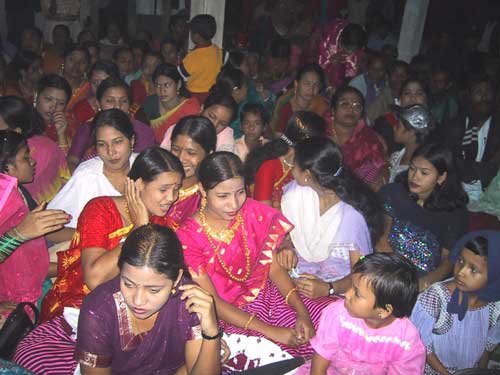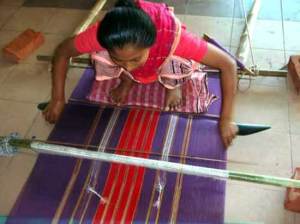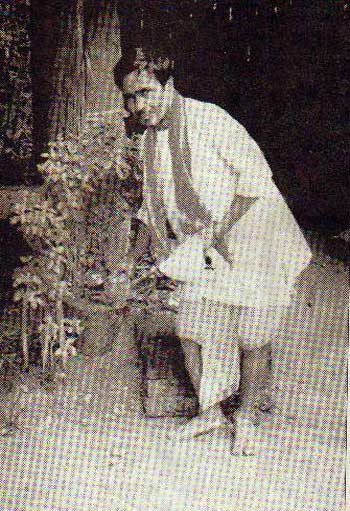To many of us, the name Manipuri stands for colorful hand-woven saris and shawls. To other it is synonymous with classical dance. But the exotic images tell only part of the story, Beyond the colorful facade, the history of the Manipuri people is one of conflict, deprivation and exile. Following political intrigue in the eighteenth century, a large number of Manipuri fled their homes and took refuge in greater Sylhet, as well as the Indian states of Assam and Tripura. These people had Indo-Aryan features and called themselves Bishnupriyas. Long before their exodus they had lost control of Manipur to the rival clan of Meiteis. In their adopted land their lives and limbs were safe; but their language and culture began to lose ground against those of the majorette. Meanwhile, the Meiteis in Manipur became vindictive and imposed a de facto ban on Bishnupriya language and custom. The Bishnupriya Manipuris were caught between a rock and a hard place. Today, young Manipuris are no longer sure of their cultural identity. Elders worry that their rich heritage may not be preserved for posterity… An Article written By Syed Zainul Akmal Al-Mahmood, Sylhet, Bangladesh.

.
The Village of Ghoramara, 5 miles south of Bhanugach rail station in Moulvibazar district, is buzzing with excitement. It is the eve of Durga Puja and there is to be performance of Ras Lila, beginning at midnight. The Ras is a unique Manipuri function – the dance drama that put Manipur firmly in the cultural map of subcontinent.
“Ras Lila depicts the love affair between Srikrisna and Radha” said Swapan Kumar Singha, interne doctor at Sylhet Osmani Medical college Hospital. “We attach a lot of importance to this dance. It is one of the highlights of our social colander.”
In times of yore, the Ras may have been performed by the Sevadasis of temples, but these days it very much a socio-religious ritual in which amateur artists perform with gustho. A group of fifteen has been practicing behind closed doors for weeks.
We go on a tour of the Mandap, the covered area in front of the temple where the Ras will take place. Workers are busily constructing a fancy stage – a round enclosure, all frills and intricate designs. Elder look on with solemn attention while small children, rosy-cheeked with excitement, dance and play.
The Manipuris follow the Vaishnavite faith. They are worshippers of Bishnu(Vishnu). Singing, dancing and the love of Radha Krishna are a way of life with them. But I’m intrigued to see the goddess Durga holding court on a low dais. How is it, I asked Swapan, that they observe Durga Puja following Shakto rites? He shrugs, “ Its all part of the general mix-up!”
“Mixed-up” is the right phrase to describe the society. The most controversial class of people”, said GK Ghosh in his book ‘Tribal and their culture in Manipur and Nagaland’, “ having no homeland of their own, subsequently losing their identity are Bishnupriyas. Rival clan claim they are not “real” Manipuris. The clues of this riddle lie in the checkered history of Assam.
.
Children of the wide Lake
Manipur is situated in on the eastern flank of present day Assam. It has quite a long history, although the name itself appears to be of relatively recent origin. In the Allahabad stone piller inscription of Samudra Gupta(4th century AD) there is no mention of Manipur, although the neighbouring kingdoms are named. According to the Mahabharata, the anicent name of this country was ‘Meckley’ and this is the name that was used when King Gaursham signed a treaty with the British in 1763. Manipur-or Meckley -is actually on a tableland surrounded by hills. It has a large lake-eight miles by five-called Logtak. The people of southern China called this land Meung-kha-la (Meung=Land ; Kha=Lake; La=Wide) and it is clear that this is where the name Meckley derives from.
In the plains beside the lake lived a race of people who had sharp Indo-Aryan features and used a language, which was similar to the Kamrupi tongue rather than the Burmese-Chinese group. These were the Bishnupriyas. For centuries these people have been called ‘Khalachai’ which in southern Chinese dialect menes ‘Children of the wide lake’ (Kha=Lake; La=Wide; Chai=Children). The other race in Manipur, the Meitheis, moved in from chinese territory and this is reflected in the name. Meithei means,, in Chinese, ‘people of this country’ i.e., Chinese territory. “It is quite probable that the kalachaias are the first cultural race in possession of the Manipur valley,” wrote Rajmohan nath in’The Background of Assamese Culture’.
Vaishnavism arrived in Manipur in 1737 in the form of Santadas Babaji ,an enterprising Bengali Baishnad of the Sri Chaitanya School . He came over the hills from Sylhet and captivated the entire population, including the king, with his melodious Kirtana, depicting the life of Radha-Krishna . Overnight, Vaishnavism became the royal faith. It is said that Santadas instigated King Pamheida alias Garib Nawaz to burn all the historical documents in order to make a clean break with the past . Thus, between a ruthless king and ambitious gurn, the history of Manipur was obscured.

There is a story that King Pamheiba ordered all his subjacts to bath in the Nongkhrang lake in order to purify themselves. The Bishnupriyas led by the Khumal chieftain initially refused, claiming that they were already purified through adopting the Bishnad faith earlier. Indeed, the influence of the Shankar Dev school of Vaishnavismmcan still be seen in Bishnupriya Manipuri culture ( GK Ghosh, Tribals and their Culture) . This dispute only widened the existing rift between the Bishnupriyas and ruling Meithei class . Large numbers of Bishnupriya Manipuris begen to migrate out of Manipur. this process was hastened by repeated Burmese attacks and soon the once-proud Bishnupriyas became a nation of refugees.
.
Back to the village…
Meanwhile back in the village, Ghoramara, preparations for the Ras are going smoothly. Swapan’s cusin Subhasini will be one of the performers. She returns from the final drees rehearsal to report that everything is fine. There is a bit of worry regarding the young boy who will play Krishna, “Krishna is very naughty”, says Subhasisni., “ he’s constantly needling the master ‘Give me another sweet or I wont dance!’ that sort of thing.”
Ghoramara is no dearth of bright young faces. Manipuris in Bangladesh acquired themselves well. There are Doctors, Engineers, and University students. Kungo Thang is a final year computer science student of BUET. He is resentful of the influence of Brahmins in the society. “We are Vaishnavs”, he says, “So we shouldn’t have a caste system. The Brahmins have undue influence because of view that only Brahmins can be priests. The system should be done away with.”
Amulya, a stenographer of the TNO office in Moulvibazar, disagrees, “ The social structure ensures stability. If we were dismantled overnight, we will be thrown into turmoil.” But Ashim is insistent, “ A lot of things don’t make sense,” he argues, “ There is rules that forbids marriage within clans. You can see, in a limited society like ours, this can pose problem. If you are a member of the biggest clan, finding a suitable mate can be difficult.” Swapan sighs theoretically, “ It’s a tragedy!”
.
Khamba Thoibi
Forget Romeo and Joliet, in Manipuri society Khamba Thoibi has grabbed center space. In 15th century AD, Khamba, a prince of the previously routed Khumal Royal family (probably a Bishnupriya ) fell in love with Thoibi – a princess of the Moirang clan ( probably a Meithei ). The union have been to the political advantage of both Khumals and Moirangs ; but the Moirang chief resisted on purely personal grounds. The result was tragic not only for the young lovers but also for the feuding tribes of Manipur.
To this day, popular Ballads are sung in the memory of the love affair between Khamba and Thoibi. Who knows if the affair hadn’t ended in tragedy, the couse of history might have been altered; perhaps the Bishnupriyas wouldn’t have been in exile today.
.
Literacy and the Identity Issue
It is staggering to learn that in Ghoramara, 100% of the population is literate. There are no millionaires but there are no beggars, either. Everyone works. The women work hardest of all. Swapan’s sister Jharna is a schoolteacher. She is also homing in an MA in Bangla. In between she helps with the housework’s and also finds time to play active rule in Adhunik (Now Manipuri Theatre), the village drama society.

Rajkanta Singha, headmaster from a local high school not far from Ghoramara. He talks at lengths about the problem facing Manipuri society.
“Our problem is not poverty, or literacy”, he says, “A Manipuri never starves because we are clever with our hands. The problem is that we have been so preoccupied with mundane day to day that we have forgotten who we are. We’ve neglected our sense of identity and some people are taking advantages, claiming we don’t have one!”
“ Do you know the Meiteis have passed laws in Manipur, forbidding the Bishnupriya Manipuri Language? Can a civilized people do that? They are trying to rob us with our identity. They talk about ‘Real Manipuri’ is rubbish! They should live and let live.”
Rasmahan Singha, principal of Manipuri Fine Art Academy, who went England during the Bangladesh festival, strikes a similar notes. “ we have been asleep too long. Now our very existence is threatened. Do you know if you ask me the name of a scholar among us, an authority on Manipuri matters, I would be at a loss, We have no one!”
.
To be contd…







